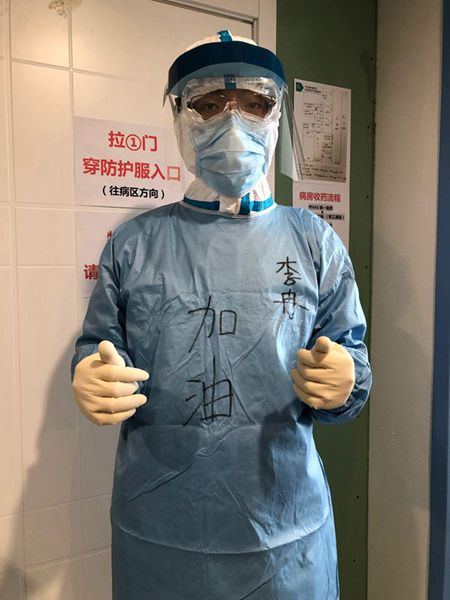Rushing to Wuhan: Doctors join in fight against novel coronavirus outbreak
- By Zhang Lulu
 0 Comment(s)
0 Comment(s) Print
Print E-mail China.org.cn, February 13, 2020
E-mail China.org.cn, February 13, 2020
Dr. Li Ran was at the start of his night shift in Wuhan's Tongji Hospital on Feb. 9 when a patient was rushed in by ambulance.

The elderly man was in a shock, and all the medical indicators pointed to a dire situation — his heart rate was 200 beats per minute, his breathing was abnormally rapid, and his blood oxygen level was way below normal.
At first, Li thought the man was beyond cure. But after he was put on high-flow nasal cannula — a special breathing machine — the patient showed signs of improvement after just two hours. When Li checked on him two days later, the elderly man was in an even better condition.
"I thought it was a miracle," Li recalled.
This miracle was exactly what Li set out to do when he rushed to Wuhan on Jan. 26. He was among the first batch of 20 doctors and nurses of Peking University People's Hospital to answer the call, and they were part of the first group of 121 medical workers sent by the National Health Commission from Beijing.
The group was given the name of the National Medical Team, and they have been joined by thousands more from across China in Wuhan and Hubei province to fight against the novel coronavirus outbreak.
Li admitted he was nervous. "It was impossible not to be worried after seeing how severe the outbreak was. But as a doctor from the respiratory department, I couldn't and wouldn't leave myself outside of it."
Li's colleague, chief nurse of the respiratory department Wang Wen, was less anxious, having gone through the 2003 SARS outbreak. She was in fact anticipating the call to go to Wuhan after learning from the news that Shanghai had sent a team on Jan. 24. She packed her bags that very night — on Chinese New Year's Eve — and volunteered the next day.

The challenges awaiting them in the epicenter of the outbreak, however, were mountainous. With no special cure for the disease, doctors must work tirelessly to treat the symptoms of the infections. Li said he and his fellow doctors mostly rely on breathing machines — often advanced ones — to give life support to patients suffering from pneumonia, and that people in the most danger are the elderly and patients with pre-existing illnesses.
While they worked to treat the ever increasing number of people infected — the number of confirmed cases in Wuhan has risen to 32,994 as of Feb.12 — the doctors and nurses also take all precautionary measures to protect themselves. They are covered head-to-toe in protective suits, goggles, and respirators. After a long shift in the thick gears, doctors are often drenched in sweat.
"Putting on the protective suits was itself an energy-consuming process, and you feel breathless in that suit," Li said. The 33-year-old has previously worked in the Tibet autonomous region, but he said it feels even harder to breathe in the suit than on high-altitude plateau.
Meanwhile, Wang and her fellow nurses are tasked with taking care of everyday needs of patients in quarantine. With sometimes entire families infected by the virus, many can only rely on the nurses to take care of them — from getting meals to going to the bathroom.
Both doctors and nurses also work to console their patients, so that panic cannot do more harm than the disease. Some of the patients spoke only local dialect, making the communication more difficult.
Despite all the challenges, Li and Wang both said they were never for a second feeling hopeless. Wang was especially proud of her team. "We might not notice this in everyday work before this, but when we came here, we took care of each other as brothers and sisters. Everyone was asking to do more so that their colleagues can get more rest."
She said she was also encouraged by seeing patients recovering from the virus, and many have. As of midnight of Feb. 11, a total of 4,740 patients across China infected with the novel coronavirus had been discharged from hospital after recovery.
"It was really a worthwhile thing to do, to save some patients back from the verge of death," Li said.





